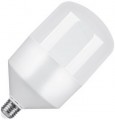Consumption
The power consumed by the light bulb during normal operation. The lower this indicator, the more economical the model and the cheaper it will cost to operate. In traditional incandescent lamps, the brightness of the glow also depended on the power, however, different types of lamps are presented on the modern market, with different efficiencies. Therefore, it is possible to uniquely link the power consumption and brightness only in lamps of the same type (see above), and to compare different types of models, you need to use the LON analogue (see below).
General-purpose bulb
A parameter that describes the brightness of the lamp compared to a general purpose lamp (LON — a conventional incandescent bulb). Simply put, an analogue of LON is the power of an incandescent lamp, which is equal in brightness to the model in question. For example, a
75W LON analogue means that the lamp glows as brightly as a 75W incandescent lamp.
This parameter appeared for the convenience of evaluating and comparing different types of lamps in terms of brightness. Data on the luminous flux say little to the average user, and it makes no sense at all to evaluate the brightness by power — different types and even different models of lamps of the same type can differ markedly in efficiency. On the other hand, many users are accustomed to dealing with incandescent lamps, and comparison with such a lamp is familiar and understandable to them. In addition, the LON analogue allows you to compare different types of lamps, and it can also be very convenient when replacing incandescent lamps with more economical ones: for example, if 100-watt lamps were used in the chandelier, then the new lamps must have an LON analogue of
at least 100 W — otherwise they may be too dim.
Luminous flux (brightness)
The conditional "amount of light" produced by a light bulb in normal mode. The higher the luminous flux, the brighter the light and the more clearly the illuminated scene will be visible. Note that lumen values are used primarily for special purposes; in everyday life, the estimation of brightness by the analogue of LON is more popular (see above), and here the ratio is as follows:
— 40 W analogue LON corresponds to a brightness of 370 lm;
— 60 W — 550 lm;
— 75 W — 800 lm;
— 100 W — 1200 lm;
— 150 W — 1900 lm;
— 200 W — 2700 lm.
Note that the principle "the more the better" in the case of the brightness of light bulbs is not always applicable. And the point here is not only energy consumption: too bright light is harmful to the eyes, leads to rapid fatigue and psychological discomfort.
Colour temperature
This parameter describes the general coloration of the light of the lamp in "warm" or "cold" tones.
Initially, colour temperature is the temperature (in kelvins) of an object at which it begins to glow in a certain colour. Interestingly, the higher its value, the more “cold” the colour is: for example, the dull red glow of a heated metal corresponds to 800-1000 K, and the bluish-white tint of a fluorescent lamp corresponds to about 6000 K.
The temperatures encountered in modern light bulbs can be described approximately as follows:
2700 – 3000 K — "warm" white light, similar to traditional incandescent lamps;
3000 – 3500 K — "slightly warmer than average";
3500 – 6000 K — neutral white, similar to daylight;
More than 6000 K — cold shades of white.
Note that the colour temperature is not directly related to the quality of colour reproduction provided by the light of a particular lamp — much depends on the features of its design and, accordingly, the spectral colour balance.

